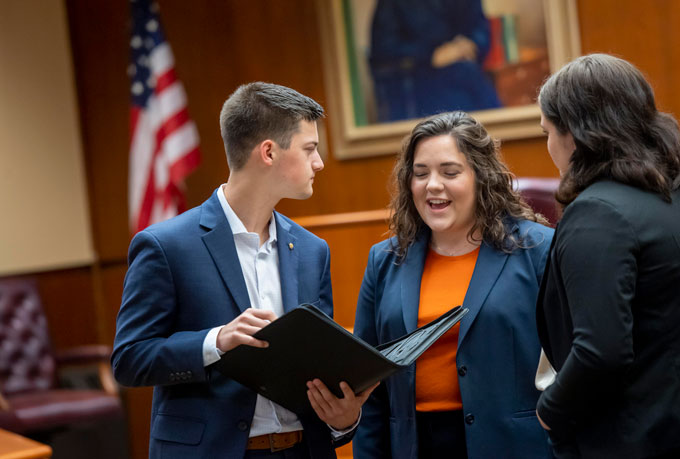Our last day in Mato Grosso

Our morning started bright and early with a standard Brazilian breakfast at the Holiday Inn in Cuiaba, Mato Grosso. We checked out of the hotel and boarded the bus by 8 AM, ready for our busy day. Over the course of the day, we attended a presentation from members of APROSOJA (Association of Producers of Corn and Soybeans in Mato Grosso) and IMEA (Economic Institute of Agribusiness), ate lunch at Cuiaba's Shopping Center, and flew from Cuiaba to Rio de Janiero.
Once we boarded the bus in the morning, we received a (heavily air conditioned) bus tour of many government buildings in Cuiaba from our host and guide, Ricardo. Eventually, we arrived at the SENA building for our presentation. SENA is a government organization that provides education to farmers and farm workers in Mato Grosso. We were led through the building to an interior classroom for the presentation.
Our first speaker was Sid from APROSOJA, who spoke about the corn and soybean industry in Mato Grosso, as well as APROSOJA's role in it. Mato Grosso is the largest soy producing state in Brazil with 23.6 tons harvested in 2012, and ranks first in second-crop corn with 16.1 million metric tons harvested in 2012. Because of the state's warm climate, this corn crop can be grown directly after the soy is harvested. This second crop season is called safrinha. Grain production in Mato Grosso is expected to increase as more land is developed and devoted to production.
APROSOJA was founded in 2005 when a price crisis drove farmers to organize themselves for more policy influence. Currently, it represents producers' political interests while providing educational initiatives, research support, and social responsibility programs. Overall, its goal is to become the reference for agricultural organizations in Brazil.
Our next presentation was from Daniel of IMEA, who spoke about cattle in Mato Grosso. The state has almost 30 million head, or 10 head of cattle for every person in the state. The main takeaway from Daniel's presentation was the changing trend of cattle production in the state. Traditionally, producers have operated a full cow-calf cycle exclusively on pasture. However, as pasture is replaced to produce grain, more intensive practices such as feedlots are being adopted. This is shown by the fact that while pasture area has decreased over the last 5 years, overall production has steadily increased.
After Daniel, we were treated to a presentation from John of IMEA regarding pork and poultry in the state. We learned that Mato Grosso is 5th in the country in pork production and 7th in poultry production, but it is predicted to rise to the top of each category in the next 20 years. This can be marked by increased slaughter capacity. For example, Brasil Foods recently constructed a pork and poultry plant capable of slaughtering 4 thousand head of pork per day. These trends show that Mato Grosso should be a meat-producing center of Brazil for years to come.
Following John, we heard from Eliza of IMEA, who spoke about ethanol production. Mato Grosso is the 7th sugarcane producing state in Brazil, but is an important ethanol producer for the northern states of Brazil. We learned that if corn prices fall below $R 18 per 60 Kg bag, corn ethanol can be viably produced in the state's mills.
This concluded the presentation schedule, and after a round of questions, our presenters were gracious enough to give us several video interviews. Following this, we departed and stopped at a shopping mall for lunch. Many students indulged in American food cravings such as Burger King and Subway, and after perusing several stores, we had to depart for the hour drive to the Cuiaba airport for our flight to Rio de Janiero.
The Cuiaba airport was very different compared to several US airports, as it was very small in size. Construction workers were renovating the airport to triple its size due to the fact that the Cuiaba airport is the main airport to the farm connections in the Mato Grosso state. Additionally, Cuiaba is one of the cities being used for World Cup games in 2014, so they're up against a tight expansion deadline. We boarded the plane and then had about a 2-hour flight to Rio de Janiero.
Finally arriving in Rio de Janiero we drove to the hotel and were amazed by the size and scale of the city. We made it to our beachfront hotel, the Olinda Rio. It is a very beautiful hotel right on the Copacabana Beach, and many of us could not wait to hit up the beach at some point during our stay. After getting situated in the hotel we had a late night dinner at the Galeto, a chicken restaurant with Brazilian family style-served dishes. While at the restaurant we celebrated Catlin Carson's Birthday. The chocolate cake was delicious and there was plenty to go around. We would like to thank Felipe for purchasing the surprise cake for her. Completing our late night meal we went back to rest up for an exciting stay in Rio de Janiero and the last 3 days in Brazil.
For more photos, click here!
